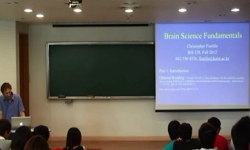The purpose of this study is to investigate the misconception of the human brain according to completion of life science Ⅰ on high school students. Generally, the misconception of the human brain is called ‘Neuromyth’, because it would apply the...
http://chineseinput.net/에서 pinyin(병음)방식으로 중국어를 변환할 수 있습니다.
변환된 중국어를 복사하여 사용하시면 됩니다.
- 中文 을 입력하시려면 zhongwen을 입력하시고 space를누르시면됩니다.
- 北京 을 입력하시려면 beijing을 입력하시고 space를 누르시면 됩니다.

The Differences of the Conception for Human Brain on High School Students according to The Completion of ‘Life ScienceⅠ’ = ‘생명과학Ⅰ’ 이수에 따른 고등학생의 뇌에 대한 개념 차이
한글로보기https://www.riss.kr/link?id=A107647425
- 저자
- 발행기관
- 학술지명
- 권호사항
-
발행연도
2021
-
작성언어
-
- 주제어
-
KDC
370
-
등재정보
KCI등재
-
자료형태
학술저널
-
수록면
149-164(16쪽)
- DOI식별코드
- 제공처
-
0
상세조회 -
0
다운로드
부가정보
다국어 초록 (Multilingual Abstract)
The purpose of this study is to investigate the misconception of the human brain according to completion of life science Ⅰ on high school students. Generally, the misconception of the human brain is called ‘Neuromyth’, because it would apply the knowledge from neuroscience to education through misunderstanding or misusage. The researcher recruited 104 high school students to analyze their misconception of the human brain, and divided them into two groups depending on the completion of life science; completed 54 students and not completed 50 students. All of the students fill out the survey to check the misconception, 16 questions in the survey were composed of three domains like learning, the function of the brain, structure of the brain. The researcher marked the score of each questionary whether correct, neutral, incorrect answer, and analyzed three domains score and total score about misconception by one-way ANOVA. The researcher was able to conclude as follows through the results of misconception analysis of the brain. First, high school students had various misconceptions related to the human brain. According to the result, it found out more than 50% of students had misconceptions of the brain in 7 out of 16 questions. Second, there are differences in misconceptions of the brain depending on whether or not students completed life science I. A result of statistical, it significantly found the difference between the two student groups. Third, there is a difference of the possibility for correcting misconceptions by the application of the life science curriculum. The misconception of brain function could change to the scientific conception more effective than other misconceptions because the statistical difference was found on the misconception of brain function.
목차 (Table of Contents)
- Introduction Research Method Results Conclusions and Educational Implications
- Introduction Research Method Results Conclusions and Educational Implications
동일학술지(권/호) 다른 논문
-
Analysis of Inquiry-based Activities in the Various Forces Unit of Middle School Science Textbooks
- 한국교원대학교 뇌기반교육연구소
- 김지은(Ji-Eun Kim)
- 2021
- KCI등재
-
An Analysis of Research Trends of Domestic Mathematics Struggling Learners Using Topic Modeling
- 한국교원대학교 뇌기반교육연구소
- 손태권(Tae-Kwon Son)안도연(Do-Yeon Ahn)
- 2021
- KCI등재
-
Educational Application in Biology of the Big Data Technology Based on Physical Computing
- 한국교원대학교 뇌기반교육연구소
- 박진선(Jin-Sun Park)
- 2021
- KCI등재
-
Tool Affordance from Interactions with Tools during Scientific Experimental Activities
- 한국교원대학교 뇌기반교육연구소
- 김성운(Seong-Un Kim)
- 2021
- KCI등재




 KCI
KCI 스콜라
스콜라





